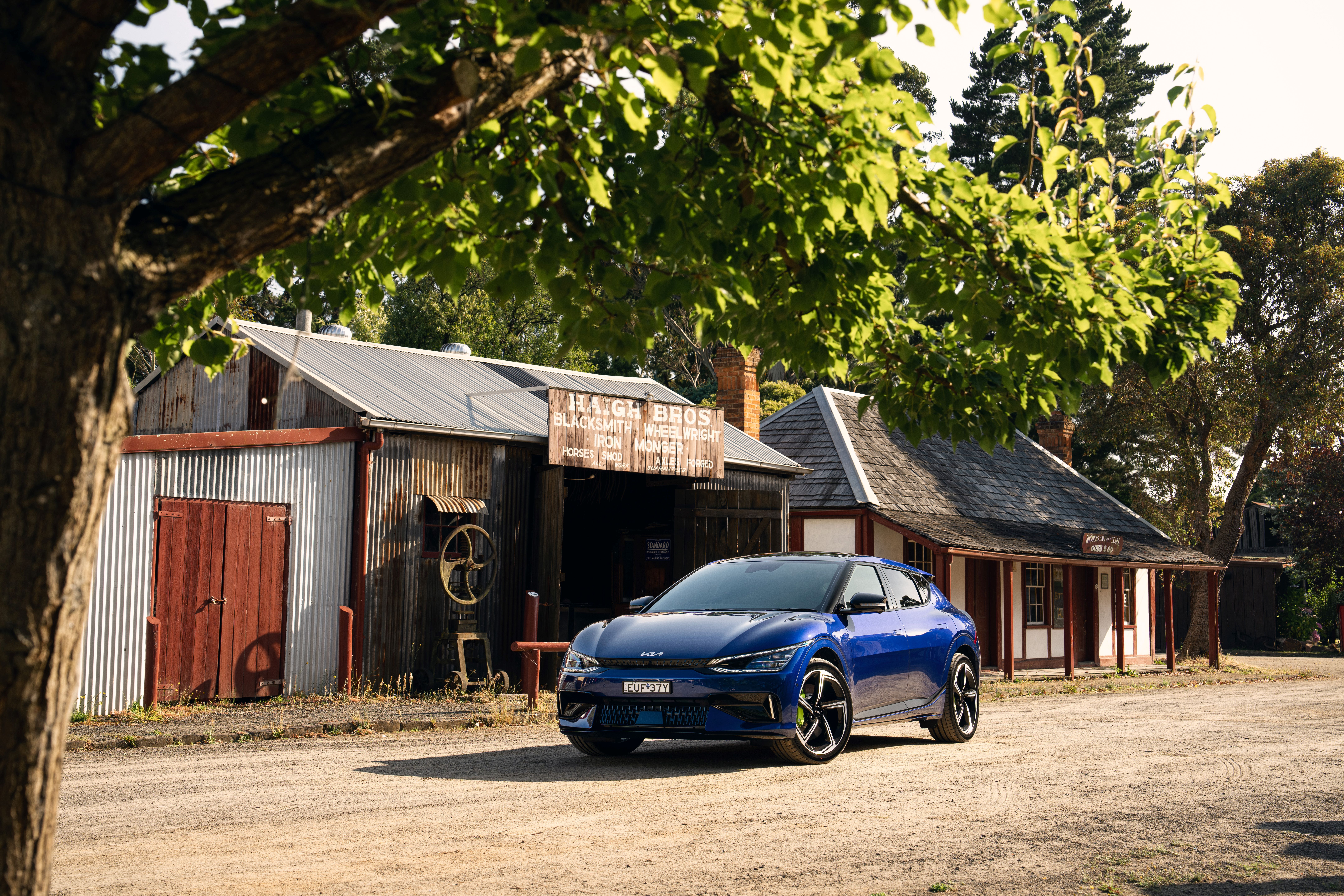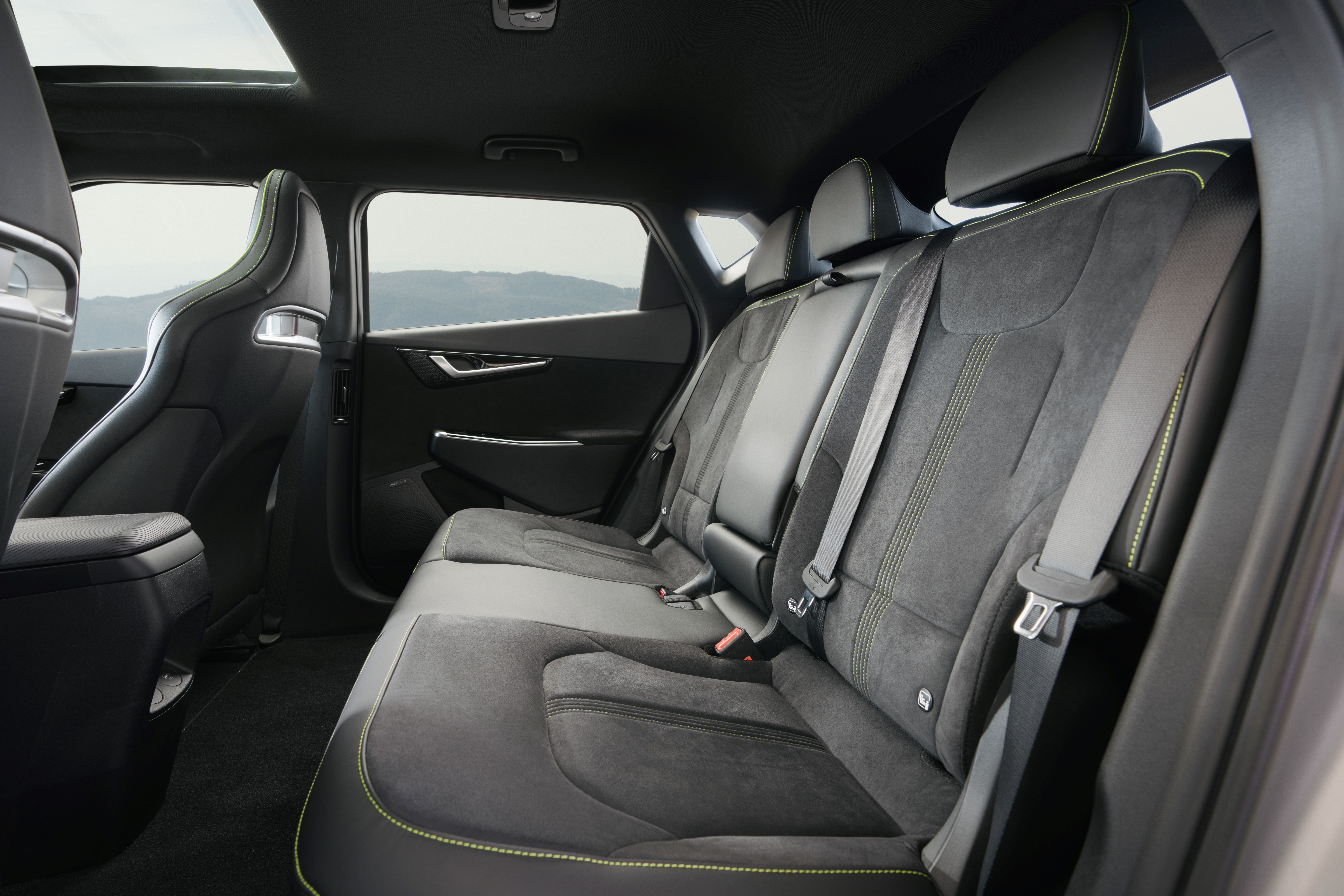Chris Riley tests the 2023 Kia EV6 GT with pricing, specs, ride and handling, safety, verdict and everything the over-50 driver needs to know.
Summary: The EV6 GT delivers the kind of performance you might never have expected from a Kia, but it comes at a hefty price.
Kia EV6 GT electric performance car
Pricing: $99,590 (plus on road costs but excluding incentives)
Options: premium paint $520, matte Moonscape Grey paint $3295, charging cable $583
Warranty: Seven-years, unlimited km. 12 months roadside assist
Safety: not tested
Build location: South Korea
Motor: two permanent magnet AC electric motors
Battery: 77.4kWh
Power: 430kW (160kW front, 270kW rear)
Torque: 740Nm (350Nm front, 390kW rear)
Transmission: single speed reduction gear auto, all-wheel drive
Body: 4695mm (long); 1890mm (wide); 1545mm (high)
Kerb weight: 2185kg
Towing capacity: 1600kg
Wheels: 21-inch alloy
Tyres: 255/40 R21
Spare wheel: repair kit
Ground clearance: 213mm
Turning circle: 11.9m
Charge time: 38 hours 0 minutes
Quick charge time: 0 hours 18 minutes
Claimed range: 424km
Official consumption: 21.1kWh/100km
Consumption on test: 20.6kWh/100km (400km)
seniordriver consumption on test: 19.5kWh/100km (302km)
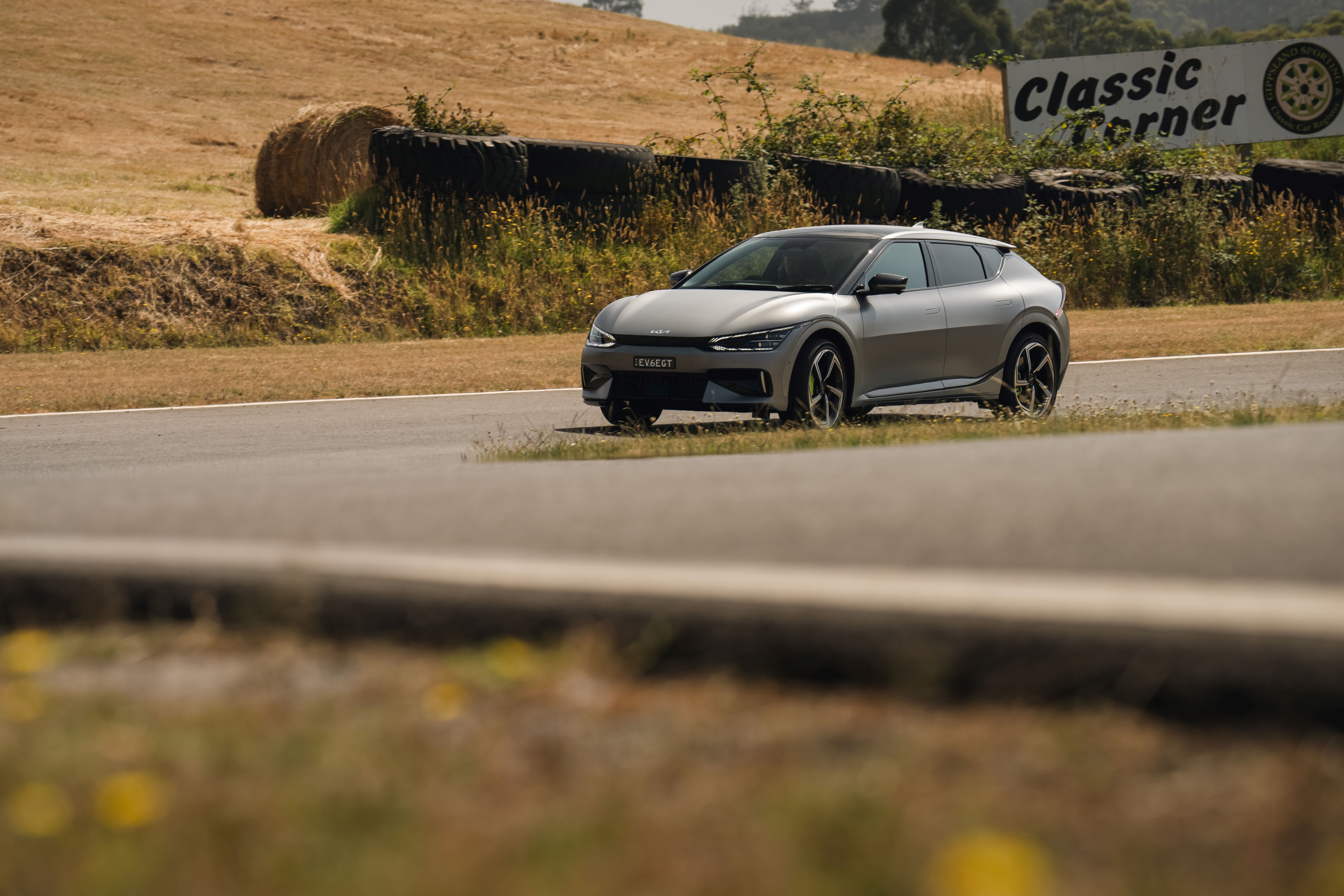
[review]
Kia’s EV6 GT is World Performance Car of the Year, who can argue with that?
To be eligible a car must be produced in volumes of at least 1000 units per year, must be overtly performance-focused in overall character and must be “on-sale” in at least two major markets during the qualifying period.
And with two electric motors and a seriously impressive 430kW of power and 740Nm of torque, not to mention a zero to 100-km/h time of just 3.5 seconds, the EV6 GT certainly meets the requirements.
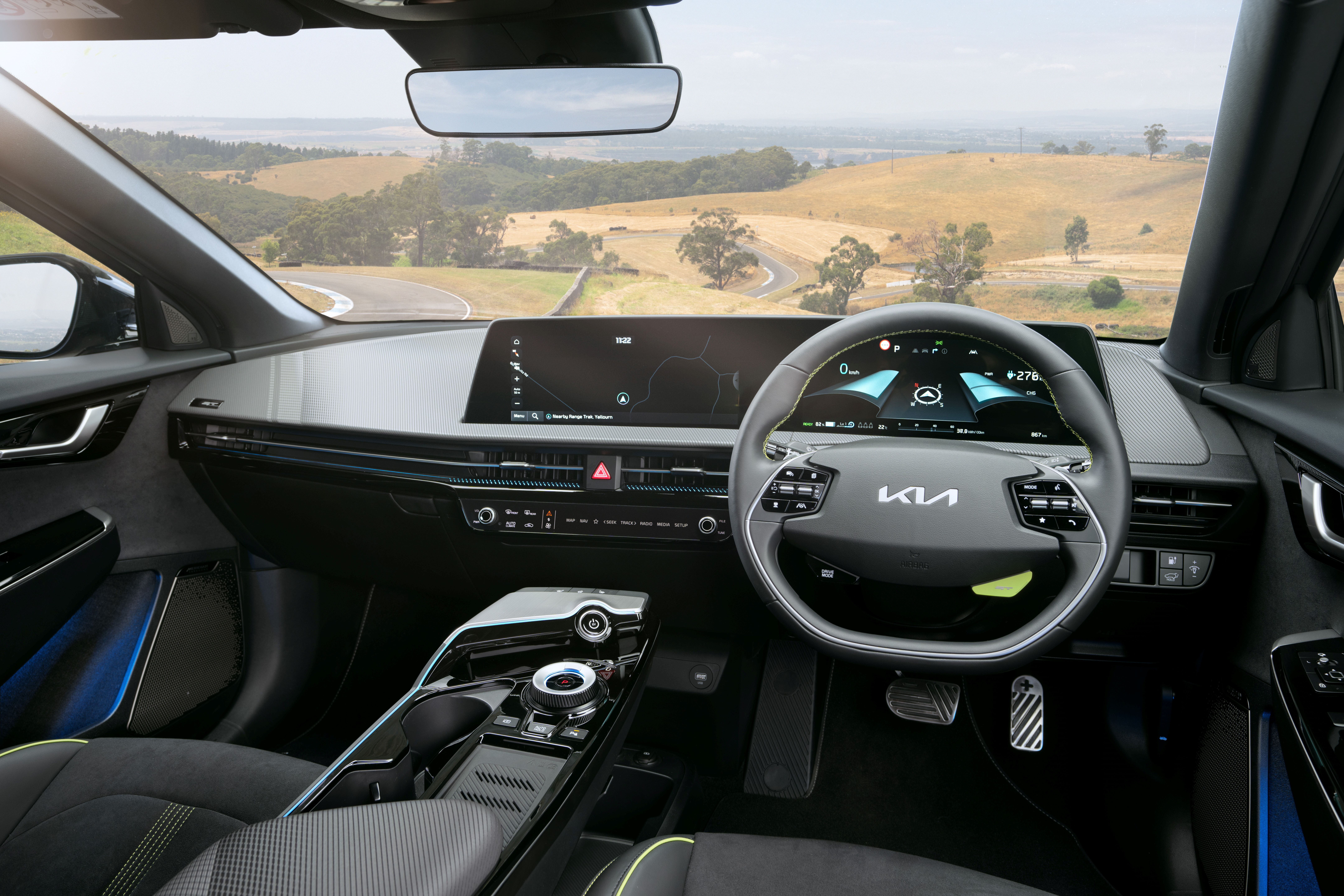
What’s it cost?
The GT sits 5mm lower than the standard EV6, with some small design mods, larger 21-inch wheels and green brake calipers.
Gloss black A-pillar, wing mirrors and belt line garnishes complete the look, with full-width tail lights and a stylish rear wing.
It’s long and surprisingly wide at almost 4.7 metres and 1.9 metres across, with a 2900mm stretched wheelbase.
This means plenty of rear legroom and a decent-sized boot.
To placate traditionalists, a grille of sorts remains at the front.
But the proportions are out of whack, with an overly long cabin that is bracketed by a short bonnet and boot.
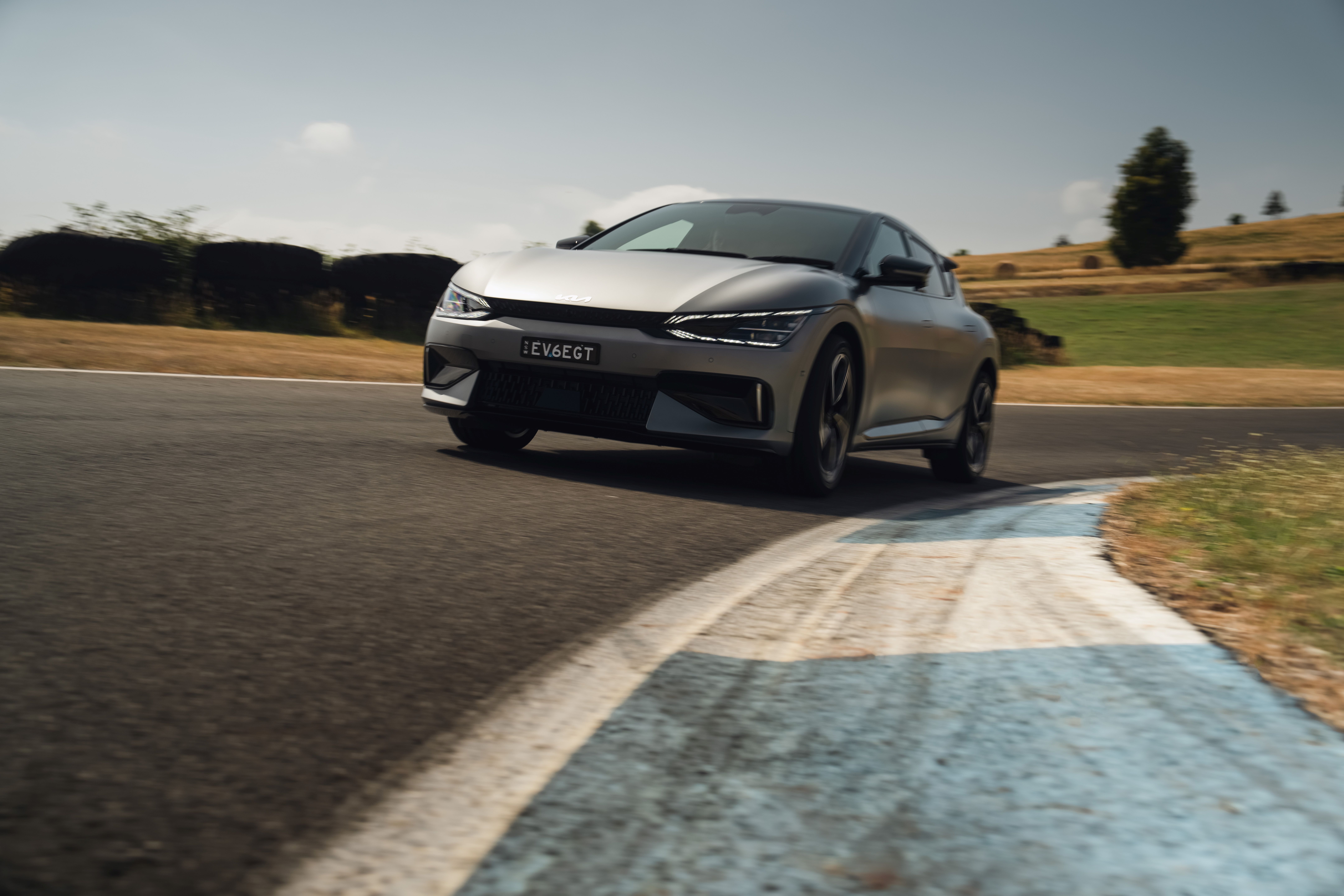
Prices start from $72,590 for the EV6 Air RWD.
EV6 GT-Line RWD is priced from $79,590, while the EV6 GT-Line with AWD is priced from $87,590.
Our test vehicle, top of the line EV6 GT, is priced from $99,950 before on-roads.
The standard colour is red, while premium blue, black or white adds $520 to the price.
Then there’s flat matte Moonscape grey that will set you back $3295.
Whatever colour you choose, the interior is trimmed in a combination of black with green piping and stitching.
Want the optional cable that allows the car to be hooked up to a pay-as-you-go charger – it’s a whopping $583 (why so much?)
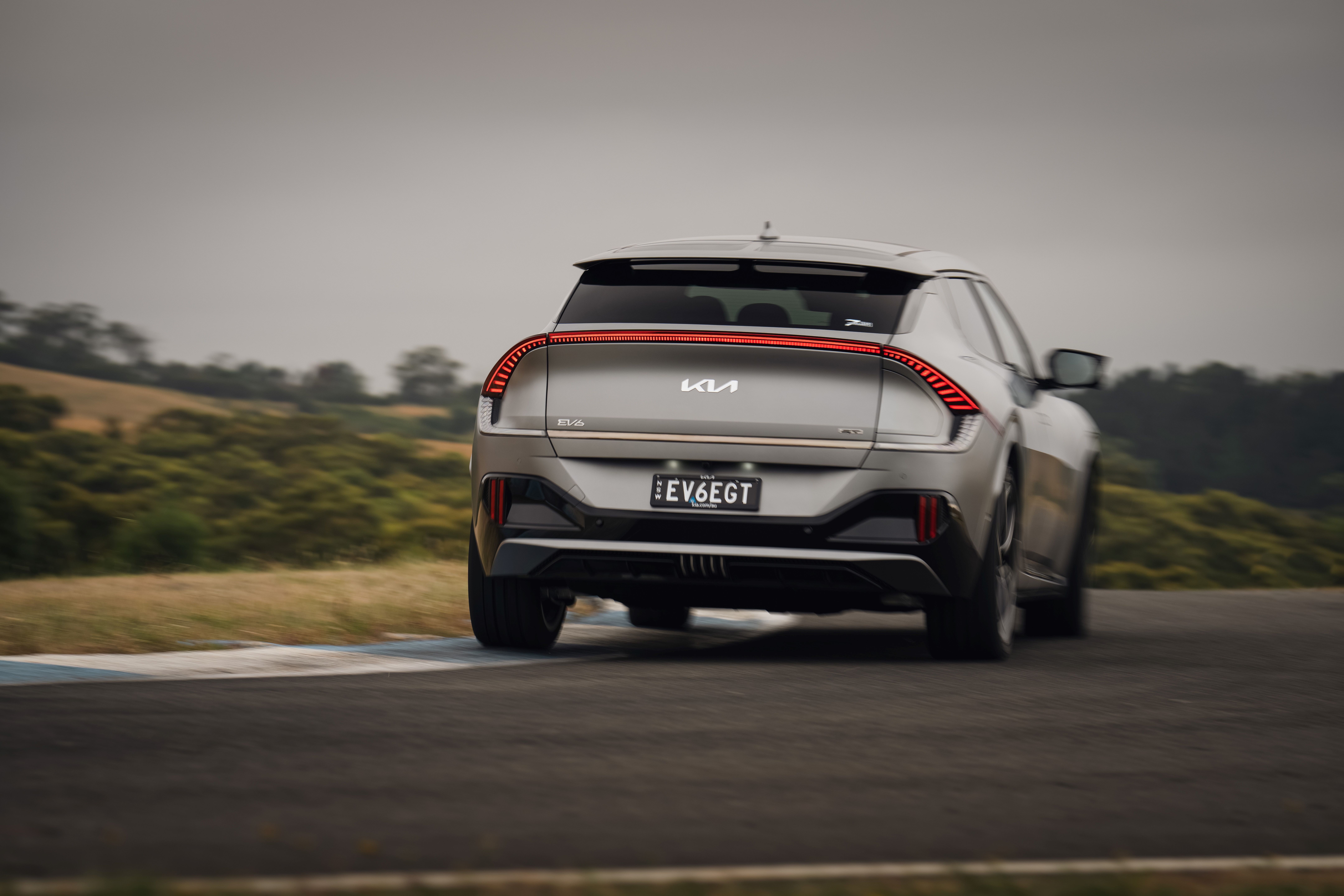
Standard kit is mostly the same as the GT-Line we drove previously, with some notable omissions.
Inside there’s dual zone climate air with rear vents and the seats are trimmed in a combination of grey artificial leather and suede with green stitching.
While the seats are heated front and back, the front seats do not recline, lack power adjustment and miss out on cooling – or ventilation as it is commonly known.
The steering wheel is heated and mood lighting remains.
There’s also follow-the-road LED headlights, folding, heated door mirrors with integrated indicators, automatic high beam, smart cruise control with stop and go, auto parallel and perpendicular parking, a tilt and slide sunroof and power-operated tailgate.
Rounding off the list is head-up display, an auto-dimming rear-view mirror, auto lights and wipers, front and rear parking sensors, along with a 360-degree camera.

Infotainment consists of a 12.3-inch touchscreen, with built-in navigation, Bluetooth, AM/FM and DAB+ digital radio, together with wired Android Auto and wired Apple CarPlay plus ‘Sounds of Nature’ ambient background noise.
Like the GT-Line it gets the premium, 14-speaker Meridian audio system.
Connect with three USB Chargers (1 x Type A and 2 x Type C) in the front tray with multimedia connectivity, plus two 12-volt power outlets (1 x boot side/1 x front tray).
Two USB ports have been removed from the rear.
Wireless Qi phone charging is standard.
Although other grades receive a five-star safety rating, the GT needs to be re-tested because the front seats are different and the centre airbag has been removed.
There are six airbags, a rear-view camera with dynamic guidelines, plus Autonomous Emergency Braking (AEB) with car, pedestrian, cyclist detection (and junction turn assist).
Other active systems include Blind Spot (including rear cross traffic assist), Intelligent Speed Limit Assist (ISLA), Lane Follow Assist (LFA), Lane Keep Assist (LKA), Driver Attention Warning with lead vehicle departure alert (DAW+), Multi-Collision Braking (MCB) and Tyre Pressure Monitoring System (TPMS).
Three top tether and two ISOfix child seat anchors are provided.
Like all Kias, it’s covered by a 7-year unlimited kilometre warranty, with pre-paid service plans available.
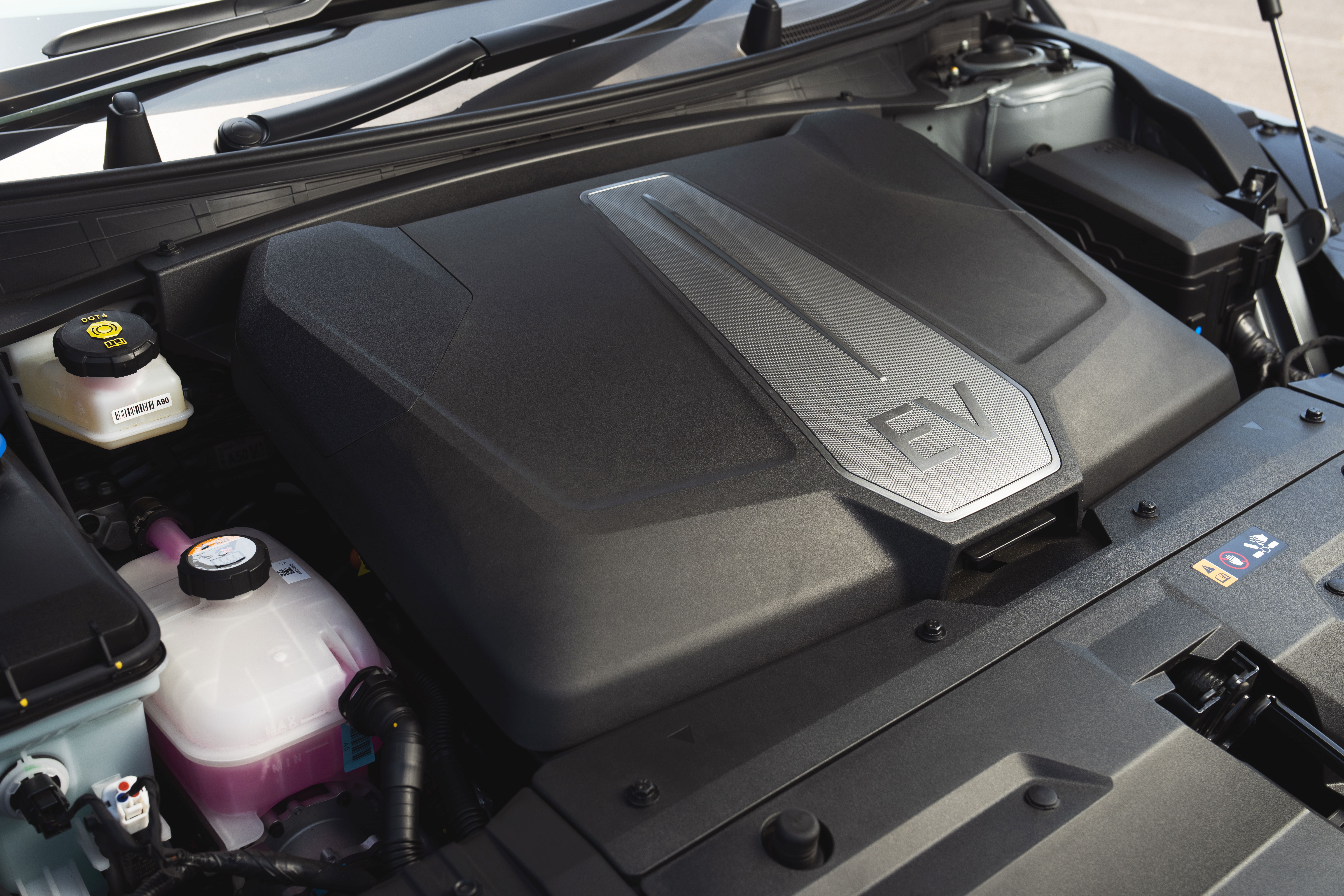
What’s it go like?
It’s quick, very quick, belying the fact it weighs almost 2.2 tonnes.
There’s no gas-guzzling petrol engine to accommodate, but the batteries, sandwiched under the floor, add 480kg to overall weight.
Set low and distributed evenly, they give the car a low centre of gravity and solid planted feel.
The GT is powered by two electric motors, with 160kW/350Nm at front and 270kW/390Nm at the rear.
They deliver a combined output of 430kW and 740Nm of torque, with maximum torque available from get-go.
Drive is to all four wheels, through a one-speed, reduction gear automatic.

The GT produces a whopping 80 percent more power than the dual motor, all-wheel drive GT-Line (239kW and 605Nm).
They’re big figures but just part of the electric experience.
Push the accelerator and the GT rockets forward, take your foot off and it stops again, almost without the need for braking, depending how close you are to an approaching corner.
It’s a feature of regenerative braking, which reclaims and stores energy for later use, and is modulated via wheel-mounted paddles (no, they’re not for changing gear).
The setup is sufficient to propel the GT from zero to 100km/h in 3.5 seconds and on to a top speed of 260km/h.
Walk up to the car and the flush-fitting, body-coloured door handles pop out in welcome.
But they are awkward to use and right-handed people might feel more comfortable opening the driver door with their left hand.
With a 77.4kWh battery, energy consumption is a claimed 20.6kWh/100km and the GT has a range of 424km (WLTP).
Say what? Given those figures, surely the range should be 376km?
The charge port is located at the rear of the car and means backing it in each time to charge.
After fully charging the car twice, it showed a range of 368km, followed by 373km the second time.
We queried Kia about the difference.
It says the figures may vary “significantly” and are influenced by previous driving behaviour, much like distance to empty is in a petrol vehicle.
“When previous driving patterns include high speed driving resulting in the high voltage battery using more electricity than usual, the estimated distance to empty is reduced.”
Sure, but what about the maths?
What it does confirm is that the harder you go in the GT, the more quickly you’re likely to drain the battery.
This all sounds very familiar. In fact, very much like driving a high performance V8.
In comparison, the entry level Air RWD model has a range of 528km; the RWD GT-Line, 504km; and the AWD GT-Line, 484km.
Four drive modes are offered along with electronically modulated suspension in the GT that adjusts based on speed, road surface, plus cornering, stopping and acceleration.
It is also designed to limit squat and dive during rapid acceleration or braking.
An electronic limited slip rear diff also helps to even out the application of power.
As well as Eco mode to maximise range, there’s Normal, Sport, GT and My Drive Mode, the latter configured to your requirements.
GT mode is accessed via a prominent green button on the steering wheel and basically turns up the wick (it turns traction off too).
Then there’s Drift Mode which sends 100 percent of torque to the rear wheels to allow the vehicle to slide easily around corners with little steering input.
When exiting a corner, power is once again applied to the front wheels to improve acceleration.
Not surprisingly, Kia warns Drift mode should only be used in a controlled environment.
Additional bracing has been added to increase body stiffness, resulting in improved vehicle response speeds and agile handling.
There’s also variable ratio steering and beefier brakes are fitted, with neon green calipers to highlight their presence, plus an electric booster to reduce braking distances (with selectable brake modes).
Adding to overall grip are 255/40 series Michelin Pilot Sport 4S tyres.
Although described as all-wheel drive, for the majority of time drive is actually to the rear wheels.
The front wheels come into play as required as shown by the instrument panel graphic.
The GT is almost unbeatable away from the lights and overtaking can be accomplished at will.
Pushing hard along winding mountain roads, the car rockets from corner to corner.
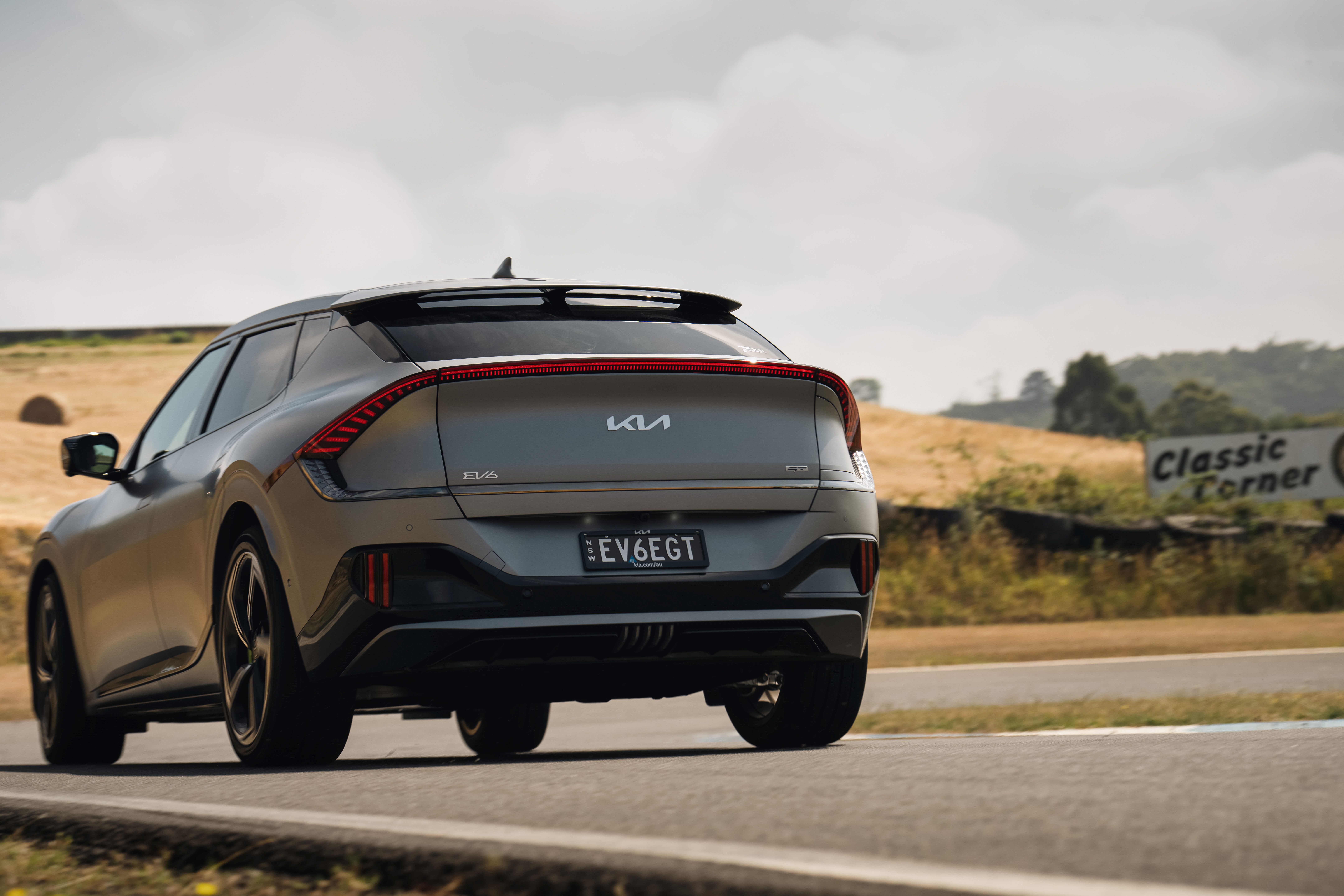
Confidence growing, braking later and later, one can feel the weight of the car start to influence handling, as it lifts off its suspension, wanting to keep going like some kind of meteorite.
But, even with traction turned off, it feels very stable, very planted and connected to the road surface. To find the limits, you’ll need a race track.
In the end, however, driving the GT starts to feel a little too easy.
You don’t have to work at it to finesse the outcome the way you do in a high performance V8 or turbo.
In the end, it just doesn’t feel as engaging.
Steering is heavy and uncommunicative and although tuned for Australian roads, the ride is hard and choppy on anything but well-formed roads.
After close to 400km of mixed driving, the trip computer was showing 21.1kWh/100km, pretty close to the 20.6 claimed.
What we like
- Electric
- Head turner
- Ferrari-like performance
What we don’t like
- Pricey
- Tyre repair kit
- Cost of additional cables
- Hard to manoeuvre when parking
What over-50 drivers need to know
Repeat after me. You do not need the EV6 GT.
You do not need that kind of power and acceleration.
At the very least you’re liable to lose your licence in the first week.
If you want an EV, there are plenty of cheaper, more sensible options available.
If you are a mature driver and must have one, then take our tip and get the entry, rear-wheel drive Air priced at a more reasonable $72,590.
It still has stacks of performance, ticks most of the same boxes and has a much better real-world range at a claimed 528km.
And it’s a stunner!

seniordriver comments
If you had told someone, five years ago, that there’d be a Kia on the market for more than $100,000 by the time you got it on the road, and that buyers would be lining up for it, they would seriously have doubted your sanity. And yet here we are.
The Kia EV6 is one of the reasons the brand has gone from “cheap and cheerful” to “aspirational”.
The EV6 GT is, without doubt, an impressive machine. But as Chris rightly points out, most people simply don’t need the performance it has on offer. But then, did we ever need the power of a big V8 when they were so common? Usually not, but some people simply have to have the biggest and best, so there will be a market for the EV6 GT, regardless of what we say.
We find it hard to understand why a car costing $100,000 should require you to stump up a further $583 for the optional cable that allows you to connect to a pay-as-you-go charger And while we’re on the value for money trail, despite its lofty price tag, the EV6 GT actually misses out on some features that are standard on the cheaper GT-Line. Front seats that don’t recline, have power adjustment or cooling? That’s just miserly.
We also had an issue with the location of the USB – something we’re finding increasingly common. Access is quite difficult (especially if your hands are arthritic or not as supple as they used to be). Both the USB socket and 12-volt power socket on the EV6 are hidden away under the floating console. When we tried to insert the USB, we managed to turn on both the steering wheel heating and the seat heating. Annoying!
The EV6 GT looks an expensive proposition until you check out the alternatives. Audi’s e-TRON is $147,400, BMW’s iX starts around $144,900 and the Jaguar i-Pace at $148,800. Arguably, they all have more prestigious nameplates, but they come at a substantial premium. Perhaps surprisingly, Tesla Model Y is actually cheaper from $98,855, but it is officially categorised as a medium-sized SUV, not a large SUV which is where the EV6 sits. It is, however, bigger all round than the Kia – go figure! If you don’t need all-wheel drive, BMW’s iX3 is close to the EV6 on all the vital statistics and starts from $104,900. Also close on paper is Mercedes-Benz’s EQB350 starting from $107,480.
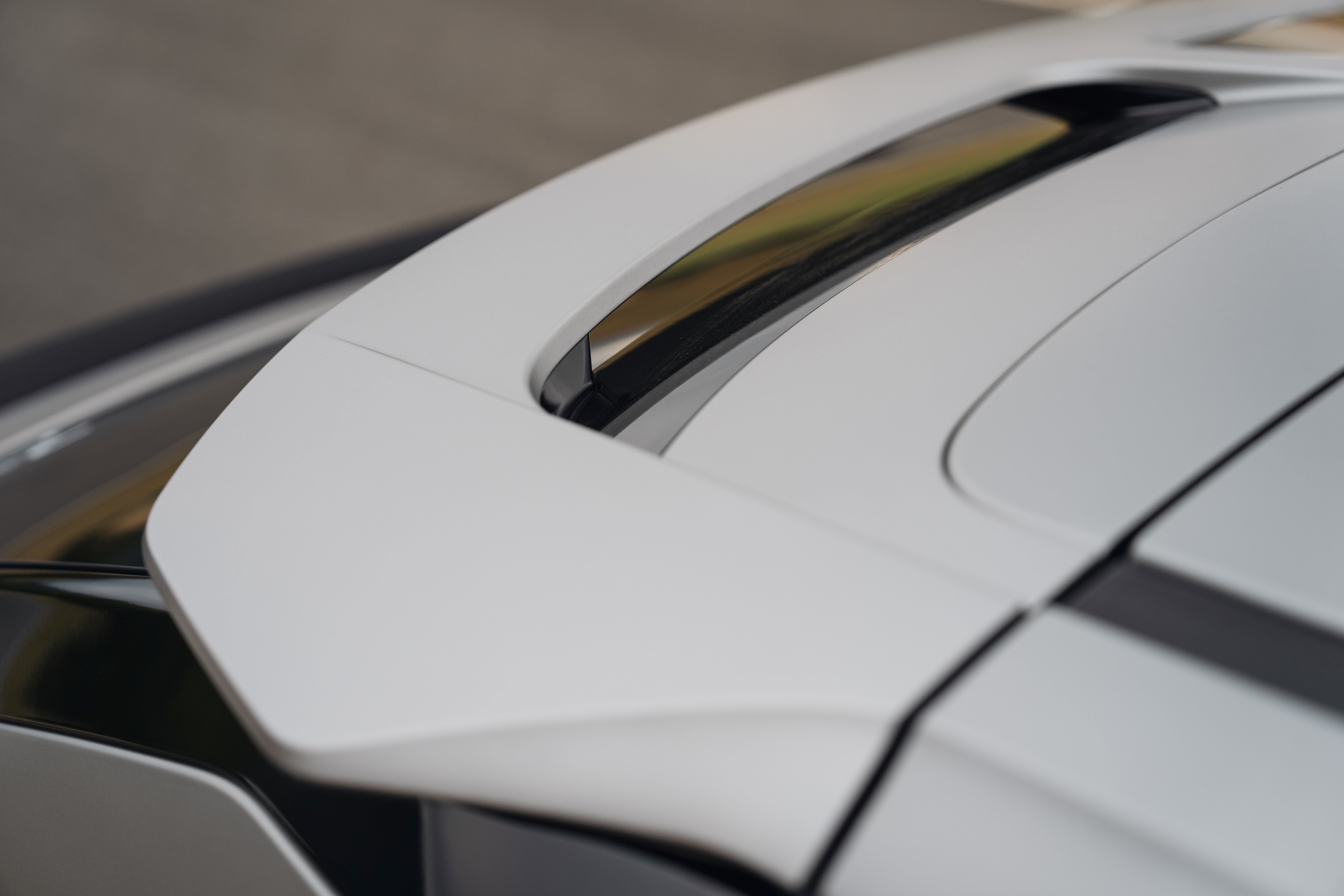
The perils of matte paint
If you’re one of those people who can’t resist the charms of the EV6 GT, can we suggest you definitely don’t option the matte Moonscape Grey paintwork. Things have changed, but when Hyundai first offered matte paintwork, it required buyers to read a multi-page document explaining what was necessary to maintain it, and sign a waiver that the owner would accept responsibility for it.
The durability of matte paint has improved in recent years and, so we’re told, it’s just as easy to care for as a regular gloss finish, but matte paint is still more susceptible to problems than gloss paint. It will collect contaminants because, unlike gloss paint, the surface is uneven (that’s how it diffuses light rather than reflecting it). Bird droppings and tree sap are tough on any paint and should be removed as soon as possible, but they won’t destroy your matte paintwork if you have to wait until you get home from work to remove them.
Matte paint will eventually etch, no matter how careful you are. When washing your car, commercial products designed specifically for matte finishes are best. Some people swear by homemade concoctions such as a mix of dish soap and vinegar, but this isn’t recommended. Some companies recommend using only water whenever possible (good luck with that!) Others suggest a solution of citric acid powder to dissolve stubborn contaminants.
Everyone agrees that automatic car washes are a definite no-no. Hand washing is the way to go.
For spot cleaning and debris removal, use matte-specific soaps and detail sprays which don’t have harsh ingredients. Obviously, don’t use a paste wax because it will fill in the surface imperfections and ruin the matte effect. Instead, use sealant products designed for matte paint – they’re actually easier to use than regular wax because you can use them even on a wet car, they don’t require cure time and won’t leave the kind of hazy residue you often get with wax on trim and emblems.
Your matte finish should be sealed every six to nine months.
Minor scratches, swirls and etching can often be buffed out on gloss paintwork, but abrasive polishes and glazes will leave permanent and unsightly shiny patches on a matte finish. The upside is that matte paint tends to disguise very minor scratches.
If a scratch or scuff shows in the clear coat or penetrates down into the colour, you’ll need professional input. Visible scratches will need to be repainted, rather than buffed out or filled using the usual DIYer techniques.
